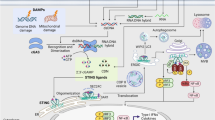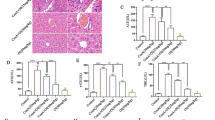Abstract
The TNF-related apoptosis-inducing ligand (TRAIL) has recently been implicated in the death of hepatocytes under infectious but not normal conditions. Infectious agents, such as hepatitis B virus (HBV), may play important roles in regulating the sensitivity of hepatocytes to TRAIL. Our previous studies showed that HBx, a protein encoded by the HBV genome, enhanced TRAIL-induced apoptosis through upregulating Bax. We report here that another HBV protein called MHBs(t) (C-terminally truncated middle hepatitis B surface protein) is also a potent regulator of TRAIL-induced apoptosis. Overexpressing MHBs(t) in hepatoma cells enhanced TRAIL-induced apoptosis. Mechanistic studies reveal that MHBs(t) had no effect on Bax or TRAIL receptor expression or procaspase-8 activation, but selectively enhanced the activation of ERK2 (extracellular signal-regulated kinase 2) and the degradation of procaspases-3 and 9. ERK2 activation is required for the MHBs(t) effect because ERK2 inhibition by its inhibitor PD98059 significantly reversed TRAIL-induced apoptosis of MHBs(t)-transfected cells. These results establish that unlike HBx, MHBs(t) enhances TRAIL-induced hepatocyte apoptosis through a novel mechanism that involves ERK2. Therefore, manipulating the ERK2 signaling pathway may provide new therapeutic opportunities to contain hepatic cell death during HBV infection.






Similar content being viewed by others
References
Liu DX (2001) A new hypothesis of pathogenetic mechanism of viral hepatitis B and C. Medical Hypotheses 56:405–408
Ksontini R, Colagiovanni DB, Josephs MD et al (1998) Disparate roles for TNF-α and Fas ligand in concanavalin A-induced hepatitis. J Immunol 160:4082–4089
Ando K, Hiroishi K, Kaneko T et al (1997) Perforin, Fas/Fas ligand, and TNF-αpathways as specific and bystander killing mechanisms of hepatitis C virus-specific human CTL. J Immunol 158:5283–5291
Kondo T, Suda T, Fukuyama H, Adachi M, Nagata S (1997) Essential roles of the Fas ligand in the development of hepatitis. Nat Med 3:409–413
Pan G, Ni J, Wei YF, Yu G, Gentz R, Dixit VM (1997) An antagonist decoy receptor and a death domain-containing receptor for TRAIL. Science 277:815–818
Wiley SR, Schooley K, Smolak PJ et al (1995) Identification and characterization of a new member of the TNF family that induces apoptosis. Immunity 3:673–682
Pan G, Ni J, Yu G, Wei YF, Dixit VM (1998) TRUNDD, a new member of the TRAIL receptor family that antagonizes TRAIL signaling. FEBS Lett 424:41–45
Schneider P, Bodmer JL, Thome M, Hofmann K, Holler N, Tschopp J (1997) Characterization of two receptors for TRAIL. FEBS Lett 416:329–334
Sheikh MS, Burns TF, Huang Y et al (1998) p53-dependent and -independent regulation of the death receptor KILLER/DR5 gene expression in response to genotoxic stress and tumor necrosis factor-α. Cancer Res 58:1593–1598
Sheridan JP, Marsters SA, Pitti RM et al (1997) Control of TRAIL-induced apoptosis by a family of signaling and decoy receptors. Science 277:818–821
Walczak H, Degli-Esposti MA, Johnson RS et al (1997) TRAIL-R2: a novel apoptosis-mediating receptor for TRAIL. EMBO J 16:5386–5397
Screaton GR, Mongkolsapaya J, Xu XN, Cowper AE, McMichael AJ, Bell JI (1997) TRICK2, a new alternatively spliced receptor that transduces the cytotoxic signal from TRAIL. Curr Biol 7:693–696
Clarke P, Meintzer SM, Spalding AC, Johnson GL, Tyler KL (2001) Caspase 8-dependent sensitization of cancer cells to TRAIL-induced apoptosis following reovirus-infection. Oncogene 20:6910–6919
Kotelkin A, Prikhod’ko EA, Cohen JI, Collins PL, Bukreyev A (2003) Respiratory syncytial virus infection sensitizes cells to apoptosis mediated by tumor necrosis factor-related apoptosis-inducing ligand. J Virol 77:9156–9172
Jeremias I, Herr I, Boehler T, Debatin KM (1998) TRAIL/Apo-2-ligandinduced apoptosis in human T cells. Eur J Immunol 28:143–152
Hu B, Zhu H, Qiu S et al (2004) Enhanced TRAIL sensitivity by E1A expression in human cancer and normal cell lines: inhibition by adenovirus E1B19K and E3 proteins. Biochem Biophys Res Commun 325:1153–1162
Tollefson AE, Toth K, Doronin K et al (2001) Inhibition of TRAIL-induced apoptosis and forced internalization of TRAIL receptor 1 by adenovirus proteins. J Virol 75:8875–8887
Kabsch K, Alonso A (2002) The human papillomavirus type 16 E5 protein impairs TRAIL- and FasL-mediated apoptosis in HaCaT cells by different mechanisms. J Virol 76:12162–12172
Walczak H, Miller RE, Ariail K et al (1999) Tumoricidal activity of tumor necrosis factor-related apoptosis-inducing ligand in vivo. Nat Med 5:157–163
Ashkenazi A, Pai RC, Fong S et al (1999) Safety and antitumor activity of recombinant soluble Apo2 ligand. J Clin Invest 104:155–162
Mundt B, Kuhnel F, Zender L et al (2003) Involvement of TRAIL and its receptors in viral hepatitis. FASEB J 17:94–96
Zheng S, Wang P, Tsabary G, Chen YH (2004) Critical roles of TRAIL in hepatic cell death and hepatic inflammation. J Clin Invest 113:58–64
Liang XH, Liu YG, Zhang Q et al (2007) Hepatitis B virus sensitizes hepatocytes to TRAIL–induced apoptosis through Bax. J Immunol 178:503–510
Liang XH, Sun WS, Gao LF, Ma CH, Han LH, Chen YH (2005) Hepatitis B virus X protein modulates the apoptosis of hepatoma cell line induced by TRAIL. Science in China(English version) 4:277–286
Liu YG, Liu SX, Liang XH et al (2007) Blockade of TRAIL pathway ameliorates HBV-induced hepatocyte apoptosis in an acute hepatitis model. Biochem Biophys Res Commun 352:329–334
Lauer U, Weiss L, Hofschneider PH, Kekule AS (1992) The hepatitis B virus pre-S/S(t) transactivator is generated by 3′ truncations within a defined region of the S gene. J Virol 66:5284–5289
Schluter V, Rabe C, Meyer M, Koshy R, Caselmann WH (2001) Intracellular accumulation of middle hepatitis B surface protein activates gene transcription. Dig Dis 19:352–363
Hildt E, Urban S, Hofschneider PH (1995) Characterization of essential domains for the functionality of the MHBs(t) transcriptional activator and identification of a minimal MHBs(t) activator. Oncogene 11:2055–2066
Hildt E, Munz B, Saher G, Reifenberg K, Hofschneider PH (2002) The PreS2 activator MHBs(t) of hepatitis B virus activates c-raf-1/Erk2 signaling in transgenic mice. EMBO J 21:525–535
Frese S, Pirnia F, Miescher D et al (2003) PG490-mediated sensitization of lung cancer cells to Apo2L/TRAIL-induced apoptosis requires activation of ERK2. Oncogene 22:5427–5435
Evdokiou A, Bouralexis S, Atkins GJ et al (2002) Chemotherapeutic agents sensitize osteogenic sarcoma cells, but not normal human bone cells, to Apo2L/TRAIL-induced apoptosis. Int J Cancer 99:491–504
Griffith TS, Fialkov JM, Scott DL et al (2002) Induction and regulation of tumor necrosis factor-related apoptosis-inducing ligand/Apo-2 ligand-mediated apoptosis in renal cell carcinoma. Cancer Res 62:3093–3099
Xiang H, Fox JA, Totpal K et al (2002) Enhanced tumor killing by Apo2L/TRAIL and CPT-11 co-treatment is associated with p21 cleavage and differential regulation of Apo2L/TRAIL ligand and its receptors. Oncogene 21:3611–3619
Xia Z, Dickens M, Raingeaud J, Davis RJ, Greenberg ME (1995) Opposing effects of ERK and JNK-p38 MAP kinases on apoptosis. Science 270:1326–1331
Tran SE, Holmstrom TH, Ahonen M, Kahari VM, Eriksson JE (2001) MAPK/ERK overrides the apoptotic signaling from Fas, TNF, and TRAIL receptors. J Biol Chem 276:16484–16490
Stadheim TA, Xiao H, Eastman A (2001) Inhibition of extracellular signal-regulated kinase (ERK) mediates cell cycle phase independent apoptosis in vinblastine-treated ML-1 cells. Cancer Res 61:1533–1540
MacKeigan JP, Collins TS, Ting JP (2000) MEK inhibition enhances paclitaxel-induced tumor apoptosis. J Biol Chem 275:38953–38956
Wang X, Martindale JL, Holbrook NJ (2000) Requirement for ERK activation in cisplatin-induced apoptosis. J Biol Chem 275:39435–39443
Chirmule N, Moscioni AD, Qian Y, Qian R, Chen Y, Wilson, JM (1999) Fas-Fas ligand interactions play a major role in effector functions of cytotoxic T lymphocytes after adenovirus vector-mediated gene transfer. Hum Gene Ther 10:259–269
Acknowledgements
This work was supported by grants from the Natural Science Foundation of China (No. 30128023, 30440040, and 30371342).
Author information
Authors and Affiliations
Corresponding authors
Additional information
Xiaohong Liang and Juan Du contributed equally to this work.
Rights and permissions
About this article
Cite this article
Liang, X., Du, J., Liu, Y. et al. The hepatitis B virus protein MHBs(t) sensitizes hepatoma cells to TRAIL-induced apoptosis through ERK2. Apoptosis 12, 1827–1836 (2007). https://doi.org/10.1007/s10495-007-0114-4
Published:
Issue Date:
DOI: https://doi.org/10.1007/s10495-007-0114-4




